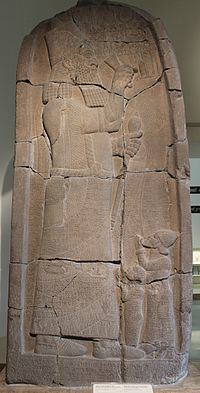Size 3.46m x 1.35m Created c. 670 BC Identification VA2708 | Writing Akkadian Cuneiform Discovered 1888 Material Diabase | |
 | ||
Similar Kilamuwa Stela, Kurkh Monoliths, Stele of the Vultures, Black Obelisk of Shalman, Victory Stele of Naram‑Sin | ||
Victory stele of esarhaddon
The Victory stele of Esarhaddon (also Zenjirli or Zincirli stele) is a dolerite stele commemorating the return of Esarhaddon after his army's 2nd battle and victory over Pharaoh Taharqa in northern ancient Egypt in 671 BC. It was discovered in 1888 in Zincirli Höyük (Sam'al, or Yadiya) by Felix von Luschan and Robert Koldewey. It is now in the Pergamon Museum in Berlin.
Contents
The prior battle of 674 BC was won by Taharqa after confronting Esarhaddon after his initial foray into the Levant; Esarhaddon then entered northern Egypt but was repulsed by Taharqa's forces.
The second battle of 671 BC saw Taharqa retreat with his army to Memphis; Memphis was taken with Taharqa then fleeing to Kush. With Esarhaddon's victory he: "slaughtered the villagers and 'erected piles of their heads'", As Esarhaddon wrote later:
"His queen, his harem, [Prince] Ushankhuru his heir, and the rest of his sons and daughters, his property and his goods, his horses, his cattle, his sheep in countless numbers, I carried off to Assyria. The root of Kush I tore up out of Egypt."Description
The stele shows Esarhaddon standing on the left in an honorific pose. He is holding a mace club in his left hand, together with a rope ending in a ring that passes through the lips of the two conquered kings kneeling before him. His right hand is addressing the gods. Cuneiform script covers the entire medium bas relief scene.
The identity of the unnamed supplicant before him has been matter of debate. He may be the king of Tyre Baal I, mentioned in Esarhaddon's Treaty with Ba'al of Tyre, or the king of Sidon Abdi-Milkutti. The kneeling figure between the two is prince Ushankhuru with a rope tied around his neck; others deem it to be Pharaoh Taharqa himself, as he is wearing the uraeus tiara of Egyptian rule.
